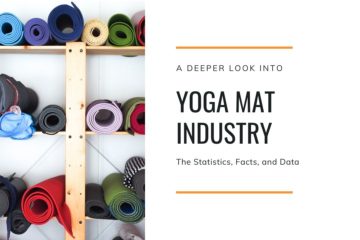Summary of Contents
What is a yoga mat?
A yoga mat is a type of mat that is made specifically for practicing yoga. It provides a non-slip and cushioned surface, which makes it easier to perform yoga asanas safely and comfortably.
However, yoga mats were far from being popular 50 years ago. Yoga was originally practiced on grass, then on skins of animals, such as deer or tigers. The animal skins provided a bit of protection for sensitive skin and offered more cushioning and stick than the bare ground, especially when it came to trickier postures.
These days when yoga became more and more popular in the whole world, towels and cotton or rubber mats were used. They come in a vast array of colors, patterns and styles. Some are eco-friendly, while others are designed to be easy to carry around and use anywhere. Yoga mats typically measure about around 68 inches (172 centimeters) long and 24 inches (60 centimeters) wide; although, there are wider variations. In terms of thickness, they start at 1 millimeter and run up to 8 millimeters, with 4 to 5 millimeters being the most common thickness.
FURTHER READINGS
- A Trip Back in Time: How the ancient yogis practiced yoga without a Yoga Mat?
- A deeper look into Yoga Mat Industry
- Natural Rubber Yoga Mat Production
- Compare different yoga mat materials
Why do yoga practitioners love to use a yoga mat?
You don’t need a yoga mat to practice yoga asanas. So why are yoga mats so popular these days? It is not just because of the yoga mat’s functional benefits but also their symbols that many yogis find connected to. Let’s find out.
1. Yoga mats help us perform yoga asanas more comfortably.
Yoga mat is designed for comfortable and safe performance of asanas and various fitness exercises. Yoga mats are great for any type of surface, preventing slipping and making training the most effective. In addition, the joint load, when using a yoga mat, is much lower than without it. This is due to easy cushioning and proper distribution of body weight.
2. Yoga mats are also a symbol.
There is no more significant symbol for contemporary yoga practice than the yoga mat. It is more than a tool employed by the yogi. The yoga mat is a metaphor. It represents the space in which our minds might experience some relief from the stress-laden, chaotic, and unpredictable nature of daily life.
3. Yoga mat serves as a private personal space.
The yoga mat does more than just provide a sticky surface. The mat defines your space. We personalize our mats to more accurately reflect who we are as practitioners. It is not just about picking the right color. We need to decide if we are going with PVC or an “eco” mat. We also need to decide on size, thickness, portability, and designs on the mat. The bare floor is public space. Everyone can walk wherever they like. The yoga mat is private space.
Some days, practice looks like rolling out your mat and lying in butterfly pose for twenty minutes. Or just standing in tadasana and seeing what happens. That simple act of gently unrolling the mat, stepping on to that space and breathing is the spark we need to move into our practice. We develop a special connection with ourself and our practice by having something that is just for our yoga. Stepping into that positive energy, the mat represents truly committing to ourself and wellbeing.
Do we really have to use yoga mats? What are yoga mat’s alternative?
If you happen to be outside and want to do an impromptu session under the trees, nothing says you must have a mat to be a yogi. Connect with the dirt, the grass, the sand — whatever you have, but watch for rocks and roots that stab into bare feet and hands.
You’ll be welcome in a yoga class without a mat, even though you might get a few stares. It’s up to you as to whether you find it completely uncomfortable to practice on the bare floor. Know that most studios will have mats that you can borrow or rent for a small fee if you don’t have your own.
If you’re participating in a restorative or Yin practice, in which most of the poses are spent lying on the floor or seated in variations of Forward Fold, you might use a folded blanket or beach towel in lieu of a yoga mat. These surfaces are inappropriate for any practice with standing poses, as they’ll promote sliding.
A thin carpeted floor with a low pile might offer enough stick for some poses, such as Warrior I or Tree pose, but you’ll be at risk of sliding when you’re in Downward Dog or even Crescent Lunge.
Yoga on a wood or laminate floor isn’t really practical without a mat. The surface is hard and will be painful on your knees, hips (when you’re in Bow, for example) and back of the skull. When you’re feet and hands produce a little sweat, you’ll likely slide. And, a hard floor is a poor conductor of heat, so it’ll feel awfully cold to your body, especially in reclined and restful postures.
Conclusion
Yoga mat or not yoga mat? It comes down to freedom. Freedom here means awareness of options and the power to make your own decisions. So this is not about using mats or not using mats. It’s about evaluating the decisions we are making, and sometimes that means being aware of the assumptions we bring to the practice. Are we assuming that we need a mat to practice yoga? What are the benefits and drawbacks of that assumption? The more conscious we make our assumptions, the more our yoga practice can become a mindful practice of freedom.
The content is compiled from these sources: Yoga International, Yogapedia, Livestrong



